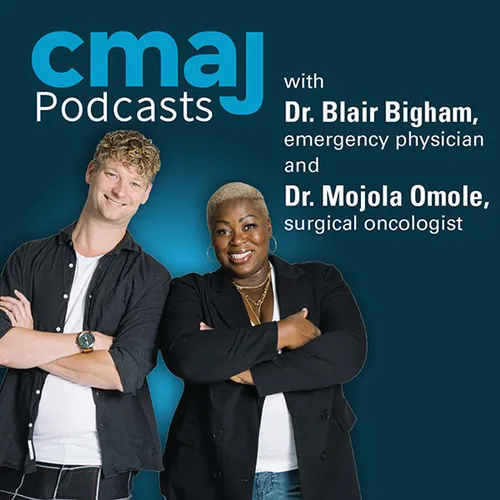
CMAJ Podcasts
CMAJ Podcasts: Exploring the latest in Canadian medicine from coast to coast to coast with your hosts, Drs. Mojola Omole and Blair Bigham. CMAJ Podcasts delves into the scientific and social health advances on the cutting edge of Canadian health care. Episodes include real stories of patients, clinicians, and others who are impacted by our health care system.
- Update frequency
- every 13 days
- Average duration
- 22 minutes
- Episodes
- 431
- Years Active
- 2014 - 2025

Genetic Perils: Allopurinol Hypersensitivity Syndrome and Personalized Medicine
Allopurinol hypersensitivity syndrome (AHS) affects approximately 1 in 1,000 patients prescribed allopurinol, with reported mortality rates between 20% and 25%. The risk of AHS is nearly 100 times hi…

How to Prevent Fragility Fractures: A Guideline for Family Doctors
Fragility fractures are a major health concern for older adults and can result in disability, admission to hospital and long-term care, and reduced quality of life.
The Canadian Task Force on Prevent…

Rethinking preoperative anemia: Challenging WHO guidelines and targeting hemoglobin levels in major elective surgery
An estimated 23%-45% of patients undergoing major surgery have anemia, with the most common causes being iron deficiency anemia and anemia of inflammation or chronic disease.
In this episode, Drs. Moj…

Diagnosing, treating and living with endometriosis
Many patients report their symptoms of endometriosis are often dismissed by healthcare providers as “normal” dysmenorrhea. This worldwide trend results in delays to diagnosis that are estimated to ra…

How to diagnose and manage polyneuropathy
Clinicians may find diagnosing polyneuropathy challenging due to the vague and insidious onset of symptoms. Identifying signs consistent with polyneuropathy and determining which investigations to co…

Redesigning streets to make them safe for bikes, e-scooters, and pedestrians
The use of electric scooters (e-scooters) has witnessed a substantial surge globally.
However, the presence of these motorized vehicles on sidewalks poses a significant risk to pedestrians. A recent p…

Understanding parents’ concerns about vaccinating their children against SARS-CoV-2
Uptake of the SARS-CoV-2 vaccine for children aged 5–11 years has been lower than anticipated in Canada. Although research has explored parental intentions toward SARS-CoV-2 vaccination for children,…

Virtual versus in-person consultation: getting the mix right
Early in the COVID-19 pandemic, Ontario saw a 5600% increase in virtual visits to health care practitioners, while in-office visits decreased by 79% from the previous year. In 2018, only 4% of family…

Diagnosing, treating and living with migraine
Migraine is a common condition that affects around 12% of adults, with a higher prevalence in women (18%) than men (6%). Global burden of disease estimates in 2019 found migraine to be the leading ca…

Diagnosing, assessing and treating long COVID
Diagnosing long COVID, or post-acute sequelae of SARS-CoV-2 infection (PASC), is challenging for clinicians. With up to 200 possible symptoms, heterogeneous presentations and no definitive diagnostic…

Looking back, looking forward with CMAJ editors
On this special episode, Drs. Blair Bigham and Mojola Omole interview CMAJ editor-in-chief, Dr. Kirsten Patrick, and executive editor, Dr. James Maskalyk. They talk about the journal's accomplishment…

Canada’s primary care crisis: addressing the causes and finding solutions
A popular theory to explain the crisis in primary care in Canada is that newly graduating physicians simply do not see as many patients as previous generations. But recently published research has th…

Managing epistaxis and identifying who may have a bleeding disorder
An “old wives’ tale” has persisted in the treatment of anterior epistaxis. A practice article in CMAJ entitled, "Five things to know about anterior epistaxis" discusses what many are doing wrong and …

Recognizing and addressing human monkeypox in Canada
A practice article in CMAJ presents 8 images of monkeypox mucocutaneous lesions presenting in Canadian patients from May to July 2022. The images show a spectrum of common lesions seen in patients w…

Exploring the promise of AI in medicine
Artificial intelligence, such as computer-aided detection and computer-aided diagnosis or differentiation uses complex algorithms to identify and characterize polyps in situ during screening for colo…

Special Episode: Tackling anti-Black racism in medicine
Efforts to combat anti-Black racism in Canadian healthcare are underway but much remains to be done to dismantle the ideas, systems and implicit biases that underpin this specific form of discriminat…

Ensuring equitable access to cancer care for Black populations
Black and immigrant populations are disproportionately underrepresented in regular screening for cancer. Race-based data from Canada are minimally-available, but research from the United States and E…

Optimizing care for patients experiencing sickle cell crises.
Several hospitals are known for providing particularly excellent care to people experiencing a sickle cell crisis. For example, the ER at UHN meets a key recommendation from the 2017 Ontario Clinica…

How to be better at diagnosing rare conditions.
Hereditary angioedema (HAE) is a rare autosomal dominant disorder characterized by recurrent episodes of painful swelling without urticaria that leads to substantial morbidity and even mortality if l…

Urgent need to improve organ donation experience for donor families
Many families of organ donors describe feeling alone and abandoned at the moment when their loved one is taken to the operating room for donation. Heather Talbot says she and her family were left on …